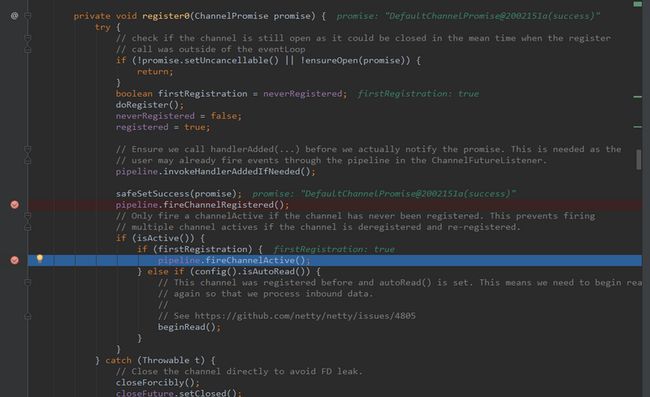背景
最近发现ChannelOutboundHandlerAdapter的read()回调方法,在连接创建成功和读取数据后都会被回调。因此就产生了疑问“为什么建立连接和读取数据后read()方法会被调用呢?” 从网上搜索到一片文章https://my.oschina.net/lifany... 可以看出一些端倪,但是具体流程和一些疑问还是没有解开。
那我也尝试着从源码找到答案吧。
Demo演示
我们先写个小Demo,其中Test1OutboundHandlerAdapter是一个ChannelOutboundHandlerAdapter,里面的read()添加一行打印。 Test1HandlerAdapter 是一个ChannelInboundHandlerAdapter 里面的channelActive(xxx)、
channelRead(xxx)、channelReadComplete(xxx)添加打印。由于很简单,下面只贴部分代码
Test1OutboundHandlerAdapter.java
@Override
public void read(ChannelHandlerContext ctx) throws Exception {
super.read(ctx);
System.out.println("Test1OutboundHandlerAdapter------------->read");
}Test1HandlerAdapter.java
@Override
public void channelRegistered(ChannelHandlerContext ctx) throws Exception {
super.channelRegistered(ctx);
System.out.println("Test1HandlerAdapter-------------->channelRegistered");
}
@Override
public void channelActive(ChannelHandlerContext ctx) throws Exception {
super.channelActive(ctx);
System.out.println("Test1HandlerAdapter-------------->channelActive");
}
@Override
public void channelRead(ChannelHandlerContext ctx, Object msg) throws Exception {
System.out.println("Test1HandlerAdapter-------------->channelRead");
ctx.writeAndFlush(msg);
}
@Override
public void channelReadComplete(ChannelHandlerContext ctx) throws Exception {
super.channelReadComplete(ctx);
} 然后我们建立连接,随便发一下数据,服务器收到数据,打印如下:
Test1HandlerAdapter-------------->handlerAdded
Test1HandlerAdapter-------------->channelRegistered
Test1HandlerAdapter-------------->channelActive
Test1OutboundHandlerAdapter------------->read
Test1HandlerAdapter-------------->channelRead
Test1HandlerAdapter-------------->channelReadComplete
Test1OutboundHandlerAdapter------------->read
如果把Test1OutboundHandlerAdapter的read(xxx)回调方法注释掉,会发现服务器无法接收数据了。
源码分析
1.channelRegistered回调流程分析
可以定位到在AbstractChannelHandlerContext invokeChannelRegistered()方法调用了channelRegistered(xxx)方法,然后再查找会发现是
AbstractChannelHandlerContext的fireChannelRegistered()----->
invokeChannelRegistered(final AbstractChannelHandlerContext next)----->invokeChannelRegistered()
AbstractChannelHandlerContext
@Override
public ChannelHandlerContext fireChannelRegistered() {
invokeChannelRegistered(findContextInbound());
return this;
}
static void invokeChannelRegistered(final AbstractChannelHandlerContext next) {
EventExecutor executor = next.executor();
if (executor.inEventLoop()) {
next.invokeChannelRegistered();
} else {
executor.execute(new Runnable() {
@Override
public void run() {
next.invokeChannelRegistered();
}
});
}
}
private void invokeChannelRegistered() {
if (invokeHandler()) {
try {
/**ChannelInboundHandler的register(xxx)在这里被调用*/
((ChannelInboundHandler) handler()).channelRegistered(this);
} catch (Throwable t) {
notifyHandlerException(t);
}
} else {
fireChannelRegistered();
}
}顺藤fireChannelRegistered()摸瓜,最终定位到AbstractChannel内部类AbstractUnsafe的
register(EventLoop eventLoop, final ChannelPromise promise)----->register0(ChannelPromise promise)
AbstractUnsafe
@Override
public final void register(EventLoop eventLoop, final ChannelPromise promise) {
if (eventLoop == null) {
throw new NullPointerException("eventLoop");
}
if (isRegistered()) {
promise.setFailure(new IllegalStateException("registered to an event loop already"));
return;
}
if (!isCompatible(eventLoop)) {
promise.setFailure(
new IllegalStateException("incompatible event loop type: " + eventLoop.getClass().getName()));
return;
}
AbstractChannel.this.eventLoop = eventLoop;
if (eventLoop.inEventLoop()) {
register0(promise);
} else {
try {
eventLoop.execute(new Runnable() {
@Override
public void run() {
register0(promise);
}
});
} catch (Throwable t) {
logger.warn(
"Force-closing a channel whose registration task was not accepted by an event loop: {}",
AbstractChannel.this, t);
closeForcibly();
closeFuture.setClosed();
safeSetFailure(promise, t);
}
}
}
private void register0(ChannelPromise promise) {
try {
// check if the channel is still open as it could be closed in the mean time when the register
// call was outside of the eventLoop
if (!promise.setUncancellable() || !ensureOpen(promise)) {
return;
}
boolean firstRegistration = neverRegistered;
doRegister();
neverRegistered = false;
registered = true;
// Ensure we call handlerAdded(...) before we actually notify the promise. This is needed as the
// user may already fire events through the pipeline in the ChannelFutureListener.
pipeline.invokeHandlerAddedIfNeeded();
safeSetSuccess(promise);
pipeline.fireChannelRegistered();
// Only fire a channelActive if the channel has never been registered. This prevents firing
// multiple channel actives if the channel is deregistered and re-registered.
if (isActive()) {
if (firstRegistration) {
pipeline.fireChannelActive();
} else if (config().isAutoRead()) {
// This channel was registered before and autoRead() is set. This means we need to begin read
// again so that we process inbound data.
//
// See https://github.com/netty/netty/issues/4805
beginRead();
}
}
} catch (Throwable t) {
// Close the channel directly to avoid FD leak.
closeForcibly();
closeFuture.setClosed();
safeSetFailure(promise, t);
}
}在继续找的会找到在EventLooop层面的调用了,我们可以先不用管了。在register0的方法中又调用了pipeline.fireChannelRegistered()和pipeline.fireChannelActive();,这正是我们要找的,也符合打印顺序先channelRegistered后channelActive。为了验证我们可以加上断点调试,就是这儿了。
至此我们可以总结一下:
channelRegistered流程:
说明
- DefaultChannelPipeline 的fireChannelRegistered()
@Override
public final ChannelPipeline fireChannelUnregistered() {
AbstractChannelHandlerContext.invokeChannelUnregistered(head);
return this;
}AbstractChannelHandlerContext.invokeChannelUnregistered(head);传递的参数是DefaultChannelPipeline的head,这样保证了register事件沿着pipeline从头流向尾,其对应DefaultChannelPipeline内部类HeadContext。 HeadContext多重身份即是ChannelHandlerContext又是ChannelInboundHandler和ChannelOutboundhandler
DefaultChannelPipeline
final AbstractChannelHandlerContext head;
final AbstractChannelHandlerContext tail;
...省略...
protected DefaultChannelPipeline(Channel channel) {
this.channel = ObjectUtil.checkNotNull(channel, "channel");
succeededFuture = new SucceededChannelFuture(channel, null);
voidPromise = new VoidChannelPromise(channel, true);
tail = new TailContext(this);
head = new HeadContext(this);
head.next = tail;
tail.prev = head;
}DefaultChannelPipeline的内部类HeadContext
final class HeadContext extends AbstractChannelHandlerContext
implements ChannelOutboundHandler, ChannelInboundHandler {
private final Unsafe unsafe;
HeadContext(DefaultChannelPipeline pipeline) {
super(pipeline, null, HEAD_NAME, false, true);
unsafe = pipeline.channel().unsafe();
setAddComplete();
}
@Override
public ChannelHandler handler() {
return this;
}
省略后边的代码2.上图黄色的部分都是调用的HeadContext中的方法
static void invokeChannelRegistered(final AbstractChannelHandlerContext next)接收的参数是DefaultChannelPipeline传递的head即HeadContext,那么也就是head.invokeChannelRegistered()。
invokeChannelRegistered()方法中会调用
((ChannelInboundHandler) handler()).channelRegistered(this);
HeadContext类中该方法返回的就是自己(可查看上面的代码),因为HeadContext本身也是ChannelInboundHandler。 同时又将自己作为参数,调用自己的channelRegistered方法
3.HeadContext的ChannelRegister方法中调用AbstractChannelHandlerContext的fireChannelRegistered();
(还是调用的自己)该方法中调用了invokeChannelRegistered(findContextInbound()); findContextInbound()所实现的功能就是查找到下一个ChanelInboundHandler即HeadContext(本身是ChannelInboundHandler)下一个ChanelInboundHandler
上面的步骤不断重复,自此registered事件可以沿着pipeline在不同的InboundHandler里流动了。
2.channelActive回调流程分析
channelActive的回调流程和channelRegister流程没有什么区别,可参考上文分析。 但是在HeadContext的channelActive方法中会调用readIfIsAutoRead(); 这个是读数据的关键
3.netty读数据分析
读数据分析


